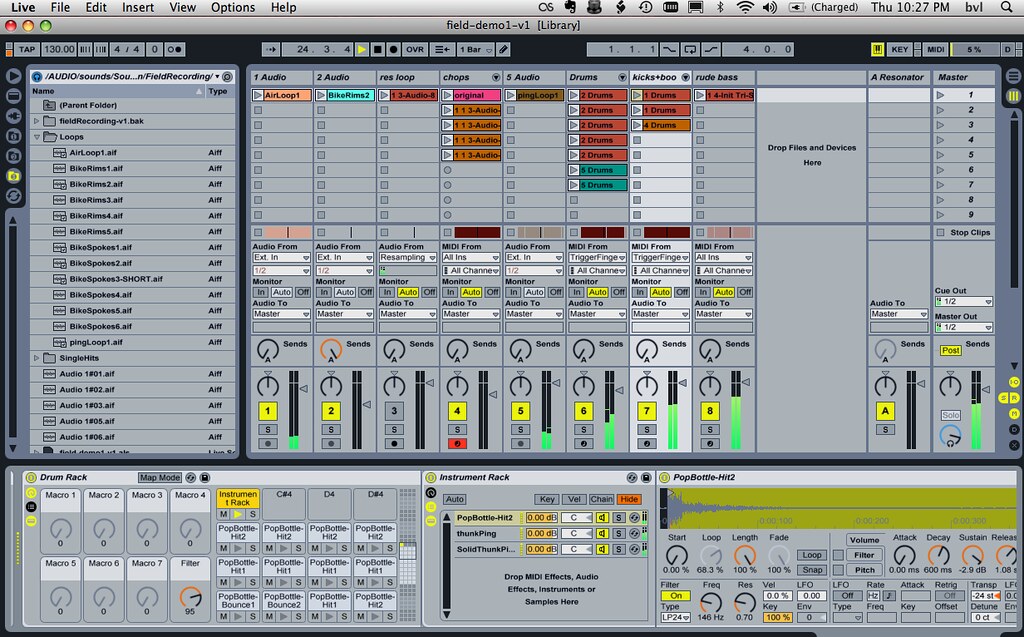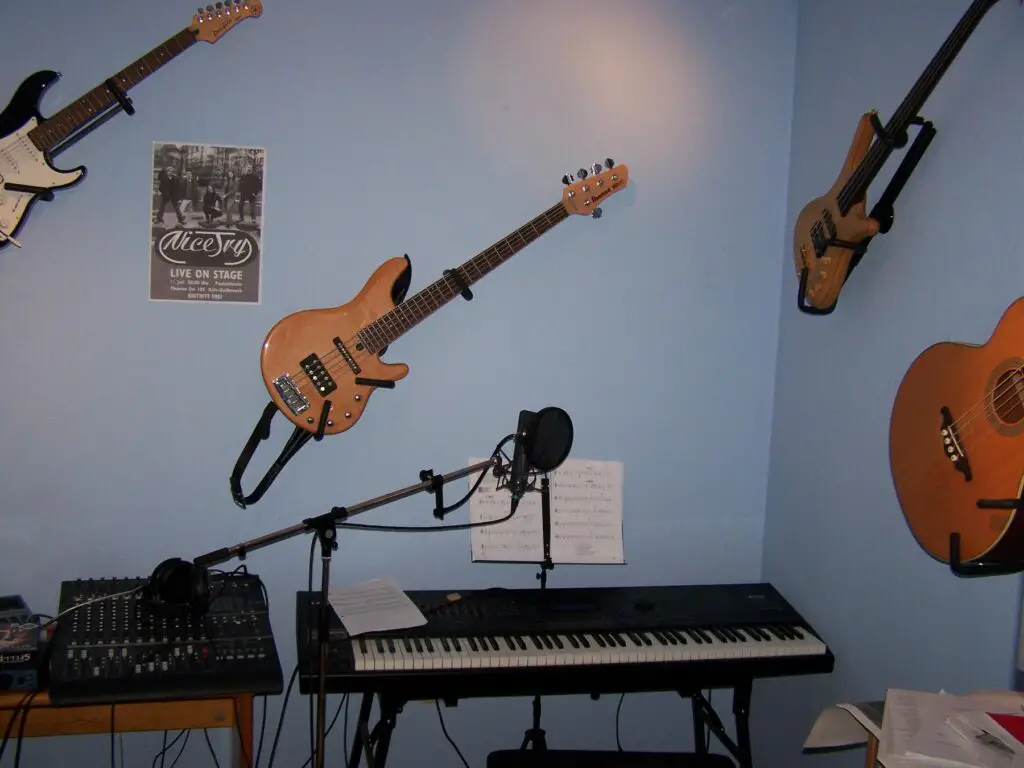
Table of Contents
Music Production Techniques
Reverse Engineering
One way to generate new ideas is to analyze existing songs and break them down to their individual parts using a technique called reverse engineering. By doing so, you can gain a deeper understanding of how different elements like melody, harmony, and rhythm work together to create a cohesive piece of music. Once you have deconstructed a song, try recreating it from scratch using your own unique elements and ideas.
Sampling
Another technique that can be used to generate new ideas is sampling. This involves taking a small part of an existing song and using it as a building block for your own composition. Famous musicians like Kanye West and Daft Punk have used this technique to create some of their most iconic tracks. However, it’s important to remember that there are legal considerations when using samples, so make sure you have the necessary permissions before incorporating them into your music.
Legal Considerations When Using Samples
When using samples in music production, it’s important to consider the legal implications. In many cases, using a sample without permission from the original artist can lead to copyright infringement and legal action. To avoid these issues, make sure to obtain the necessary permissions and licenses before using any samples in your music. This may involve contacting the original artist or their record label, or using a sample pack that has been licensed for commercial use.
Collaboration
Collaborating with other musicians and producers can provide a fresh perspective and help you come up with new ideas. When working with others, try to find people who have different strengths and skill sets than you do. This way, you can learn from each other and create something truly unique.
Personal Story: How Collaboration Improved My Music Production
In one instance, I found myself struggling with a track that wasn’t coming together the way I wanted it to. I had been working on it for weeks, but nothing seemed to click. That’s when I decided to reach out to a colleague who I knew had expertise in the particular genre I was working in.
We started collaborating on the track, and within hours, we had completely transformed it. By bouncing ideas off of each other and building on each other’s strengths, we were able to create a track that was far better than either of us could have done on our own. Collaborating with someone who had a different perspective and skill set than I did helped me to break out of my creative rut and come up with something truly unique.

Songwriting Tips
If you are a songwriter, you know how important it is to come up with new ideas for your music. Here are some tips that can help you elevate your songwriting game:
Start with a Chord Progression
A chord progression is a series of chords played in a specific order. Starting with a chord progression can provide a solid foundation for your song and help you come up with a melody. Try experimenting with different chord progressions until you find one that resonates with you. You can use music software, such as Logic Pro or FL Studio, to help you come up with unique chord progressions.
Write from Personal Experience
Writing from personal experience can add authenticity and emotional depth to your lyrics. Think about a personal experience that has had a profound impact on you and try to capture the essence of that experience in your lyrics. This can help you connect with your audience on a deeper level and make your music more relatable.
Use Word Association
Word association involves starting with a word and then brainstorming other words or phrases that are associated with it. This technique can help you come up with new and unexpected ideas for your lyrics. For example, you can start with a word like “fire” and brainstorm words like heat, flame, burn, passion, desire, and so on. You can use these words as inspiration for your lyrics.
Experiment with Song Structures
Experimenting with song structures can help you create music that is both unique and memorable. Try breaking away from traditional song structures and explore new ways to arrange your music. For example, you can experiment with verse-chorus-bridge structures, ABAB structures, or even free-form structures.
Personal Story: How I Used Word Association to Write a Hit Song
One day, I was feeling stuck and unable to come up with any new ideas for lyrics. That’s when I decided to try word association. I started with the word “fire” and began brainstorming other words that were associated with it: heat, flame, burn, passion, desire, and so on.
Before I knew it, I had a list of dozens of words that I could use as inspiration for my lyrics. I started playing around with different combinations of these words and eventually came up with a chorus that I knew was going to be a hit. By using word association, I was able to break out of my creative rut and come up with something truly unique.
Using these songwriting tips, you can take your music to the next level and create something truly special.

Mixing and Mastering Advice
Mixing and mastering are two important steps in the music production process that can take your music to the next level. Here are some tips to help you improve your mixes and masters:
Use Compression
Compression is a fundamental technique in mixing that helps to even out the levels of different elements in a mix. By using compression, you can make sure that no one element is overpowering the others, and create a more balanced and cohesive mix. Try experimenting with different compression settings to find the sweet spot that works best for your mix.
Reference Tracks
Reference tracks are songs that you use as a benchmark for your own mix. By comparing your mix to a professionally mixed track, you can identify areas that need improvement and make adjustments accordingly. When choosing reference tracks, make sure they are in the same genre and have a similar sound to your mix. Also, listen to them on the same speakers or headphones that you use for your mix, so you can hear any differences in the frequency response.
Mastering for Different Platforms
When mastering your music, it’s important to consider the platforms on which it will be played. Different platforms (e.g. streaming services, radio, vinyl) have different requirements and limitations, so make sure you are mastering your music appropriately for each platform. For example, streaming services like Spotify and Apple Music use loudness normalization, which means that all songs are played at a similar volume level. This means that you don’t need to master your music as loud as possible, as it will be turned down by the streaming service. On the other hand, radio stations may have specific loudness and frequency requirements that you need to meet.
Personal Story: How Mastering for Different Platforms Helped Me Reach a Wider Audience
I released a track that I thought was going to be a hit. However, when it was played on the radio, I noticed that the vocals were barely audible. I realized that I had made the mistake of mastering the track for streaming services rather than for radio. I immediately went back and re-mastered the track for radio, and the difference was night and day. The vocals were now clear and prominent, and the track sounded much better overall. By mastering my music appropriately for different platforms, I was able to reach a wider audience and ensure that my music sounded great no matter where it was played.
Remember, mixing and mastering are skills that take time and practice to master. Don’t be afraid to experiment and try new things, and always trust your ears. With these tips and some hard work, you can take your music to the next level and create something truly special.

Music Production Software
When it comes to music production, having the right software can make all the difference. There are a variety of options available, each with their own unique features. Here are some of the most popular types of music production software to consider:
Digital Audio Workstations (DAWs)
DAWs are software applications used for recording, editing, and producing music. They offer a powerful set of tools for music production and are essential for any serious musician or producer. Some popular DAWs include:
- Ableton Live: A versatile DAW that is great for live performance and electronic music production.
- Logic Pro X: A well-rounded DAW that is popular among Mac users and is great for recording, mixing, and mastering.
- Pro Tools: A professional-grade DAW that is widely used in the music industry for recording, editing, and mixing.
Each DAW has its own strengths and weaknesses, so it’s important to choose the one that best fits your needs and preferences.

Additional Sources of Inspiration and Ideas
Spend Time in Nature
Spending time in nature can provide a sense of calm and clarity that can help to stimulate creativity. Take a walk in the woods, go for a hike, or sit by a river and see if any new ideas come to you. The sights, sounds, and smells of nature can help to reignite your creativity and provide a fresh perspective.
Look at Visual Art
Looking at visual art like paintings or sculptures can inspire new ideas and perspectives. Try visiting an art museum or gallery and see if any artwork sparks your creativity. Pay attention to the colors, shapes, and textures in the art and see if they inspire any new ideas for your music.
Listen to Other Genres of Music
Listening to music from other genres can help to expand your musical horizons and inspire new ideas. Try listening to music that you wouldn’t normally listen to and see if any elements from those genres can be incorporated into your own music.
Collaborate with Other Musicians
Collaborating with other musicians can help to bring new ideas and perspectives to your music. Working with someone who has a different musical background or skill set can help to push you out of your comfort zone and spark new ideas.
Personal Story: How Nature Inspired My Best Work
I once found myself in a creative rut, unable to come up with any new ideas for my music. That’s when I decided to take a solo camping trip to a secluded spot in the mountains.
As I hiked through the wilderness, I found myself becoming more and more immersed in the natural beauty around me. The sound of the wind rustling through the trees, the babbling of a nearby brook, and the chirping of birds all blended together into a symphony of sound that was both soothing and invigorating.
As I sat by my campfire that evening, strumming my guitar and jotting down notes in my journal, I felt a surge of creative energy that I hadn’t experienced in years. The melodies and lyrics that had eluded me for so long were suddenly flowing out of me with ease, each one more inspired than the last.
When I returned to the studio, I felt like a new person. I had a renewed sense of purpose and an endless supply of ideas to draw from. The experience had reminded me of the importance of taking a step back and reconnecting with the world around me, and I knew that it was something I would continue to do whenever I was feeling stuck or uninspired.

Examples of Successful Music Produced Using the Discussed Techniques
To illustrate the effectiveness of the techniques described in this article, here are some examples of successful music that has been produced using these methods:
- Kanye West’s “Gold Digger” exemplifies the power of sampling in creating a unique sound. The track uses a sample from “I Got a Woman” by Ray Charles, showcasing how sampling can be used creatively.
- Daft Punk’s “One More Time” features a simple but effective chord progression that highlights how starting with a strong foundation can lead to a memorable melody. This technique can be used to create a catchy hook that resonates with listeners.
- Billie Eilish’s “Bad Guy” is a great example of how compression can be used to create a punchy and dynamic mix. This technique enhances the track’s energy and impact, making it stand out in today’s music landscape.
These examples demonstrate how the discussed techniques can be applied in different ways to produce successful music. By implementing these techniques in your own music production, you can enhance your creativity and produce tracks that stand out and resonate with your audience.

Emerging Trends and Technologies in Music Production
Music production is constantly evolving and new technologies and trends are emerging that are changing the way music is produced and consumed. These developments include:
Artificial Intelligence (AI) and Machine Learning
Artificial intelligence and machine learning are being used to analyze and manipulate music in new and innovative ways. AI algorithms can recognize patterns in music and suggest new sounds, melodies, and chord progressions, while machine learning can help producers automate repetitive tasks and improve the quality of their music.
Virtual and Augmented Reality
Virtual and augmented reality technologies are providing new ways for musicians and producers to create immersive and interactive musical experiences. VR and AR can be used to create 360-degree music videos, virtual concerts, and interactive music apps that blur the lines between music and technology.
Cloud-Based Collaboration Tools
Cloud-based collaboration tools are making it easier for musicians and producers to work together remotely and share their work with a global audience. With tools like Dropbox, Google Drive, and Splice, producers can collaborate with artists from all over the world and access their work anytime, anywhere.
By staying up-to-date with these emerging trends and technologies, music producers can continue to push the boundaries of what is possible in music production and create truly unique and innovative music.
Check out our other articles for more music production tips and techniques to help you unleash your full creative potential!

